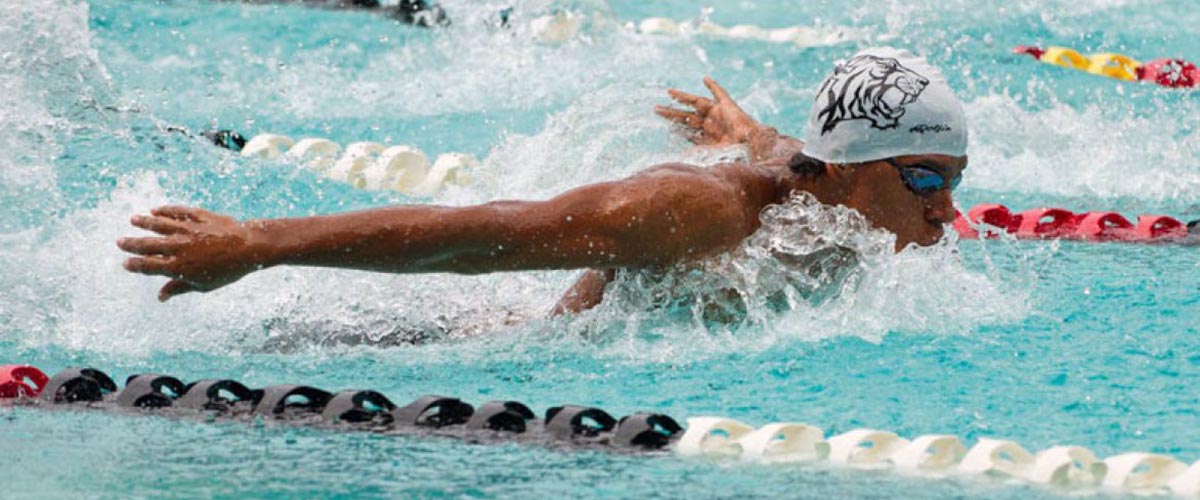How does what you do on the field affect how you perform in the fields of chemistry, biology, physics and other sciences?
As stories of Olympic victories, defeats and behind-the-scenes drama flood the air waves, we put that question to researchers at the National High Magnetic Field Laboratory. And, boy, did we get a lot of answers! Turns out many MagLab scientists moonlight as athletes of all stripes — ballet, soccer, rowing, lacrosse, running, tennis and karate, to name a few. The benefits of balancing long hours at the lab with some twirling, jumping, swinging and sweating, they say, are many. So let’s dive right in with this top 10 list (in no particular order, really) of ways practicing sports complements the pursuit of science.
10. Steer clear of the train wreck
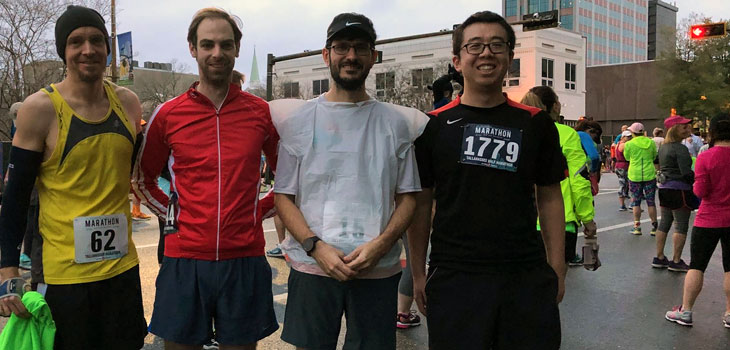
Several MagLab scientists ran the 2018 Tallahassee Marathon. Left to right: David Graf, William Coniglio, Ryan Baumbach and Wenkai Zheng.
Let’s face it: Whether you’re a senior researcher, a mid-career scientist or still toiling toward your Ph.D., a science career can take a mental toll. In a joking/not-joking kind of way, lab veteran and physicist Luis Balicas stated it bluntly.
“Sports is one important way of keeping my sanity — or at least some level of it,” quipped Balicas, who heads to the gym when he needs to blow off some science steam.
Graduate Research Assistant Ghoncheh Amouzandeh also hits the gym after a long day in the trench of science to jog, lift and stretch her way back to her mind’s happy place.
“This is very important,” said Amouzandeh, who is working toward her Ph.D. in physics, “especially for someone in graduate school, under pressure from research, thesis work, teaching and a constant background thinking about my future career.”
That pressure gets MagLab physicist Ryan Baumbach out of bed before dawn to log a few stress-relieving miles before tackling family and work responsibilities.
“If I didn’t go running, my head is way up here,” said Baumbach, his hand stretched above his head. “When I run, at least it brings down my head to a place that I can breathe. Otherwise it’s a train wreck for me.”
9. Reboot the brain
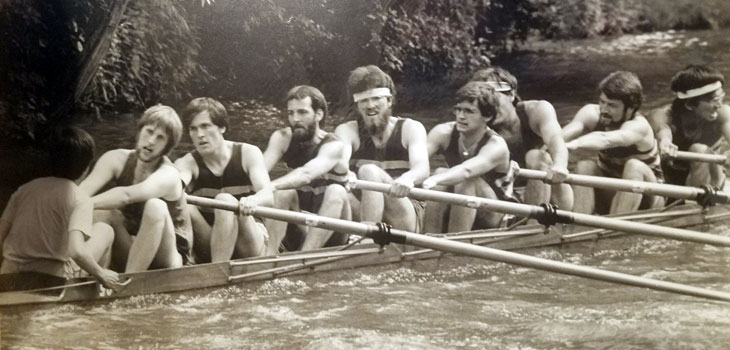
MagLab Director Greg Boebinger (fifth from right) is not thinking about science as he rows hard for Cambridge University.
Another key mental benefit of sports, scientists say: It just makes you think better.
Pilates and yoga help physicist Julia Smith cut through the cerebral fog caused by science overload.
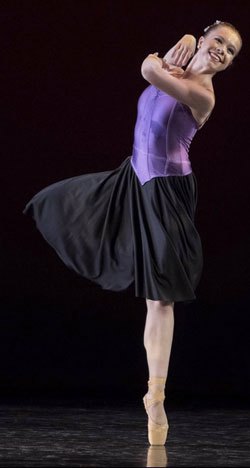
Abigail Centers.
“Generally, any type of workout helps me turn off the ‘hamster wheel’ of my brain, solving technical, scientific and logistical problems,” she said. “It’s like a system reset that my body and mind need to be able to function as a scientist doing all this brain-heavy work.”
Exercise boosts brain power by forcing scientists to think about something other than science, said MagLab Director Greg Boebinger, who rowed and played hoops as a Churchill Fellow at Cambridge University back in the 1980s.
“Every good scientist I know is constantly thinking about a science problem. In my opinion, it is why scientists have the reputation for being absent-minded and forgetful,” said Boebinger. “When you are playing basketball, you cannot be thinking about anything else; the reprieve is relieving.”
It can also pave the way to new insights, said Abigail Centers, a longtime dancer and a research assistant in computer science at the lab. The creative juices stirred by ballet, she said, help her solve problems, develop new applications and tweak old algorithms.
“I find myself more disciplined and more inclined to think outside the box every year that I dance,” Centers said.
8. Fitness feels good
Of course, the brain isn’t the only beneficiary of those pirouettes and pushups. Pretty much everything south of the cerebellum rejoices when liberated from a lab stool or office chair. That’s why Naween Anand, who played on his college team at the Indian Institute of Technology, Bombay, was thrilled to learn some fellow MagLab scientists play a pick-up game every weekend.
“It’s an office job,” said Anand of his position as a postdoctoral researcher in physics. “You sit, you do an experiment, you write papers. That’s all you do.”
Kicking around the soccer ball for a few hours every Sunday refreshes his body for the week ahead, he said.
“I think it’s really important that you do some physical work, and I think soccer is a great option,” Anand said. “You run for 140 minutes nonstop. It makes you feel good.”
7. Sizing up competition
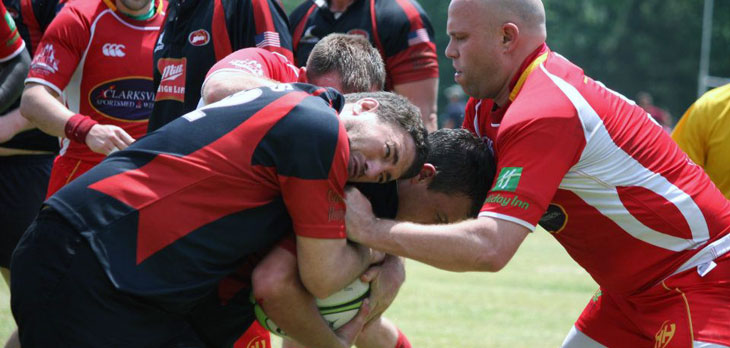
MagLab physicist Thierry DuBroca (left) tries to bring down the competition during a rugby match.
Another sports thing that feels good? Winning! It’s the prize that rewards competitive drive.
MagLab researcher Pete Morton, not surprisingly, has made something of a study of competition. An avid angler since childhood, his analysis suggests that a good athlete must outperform not one but three adversaries: his or her own perceived limitations; fellow competitors; and nature itself. When fishing, for example, he seeks to snag the biggest or most fish; to select the best spot and bait; and to outwit and outmuscle his prey and the sea itself. With that ethos, it’s perhaps inevitable that he grew up to study the ocean as a geochemist at the MagLab, where, he said, he faces the same trio of tests.
“I develop the depth and breadth of my skill set to be the best at my research,” Morton explained. “I present the best possible research strategy, balanced budget, and broader impacts to successfully argue for funding awards; and I develop methods and analytical strategies to extract accurate information from oceanographic samples.”
MagLab physicist Thierry DuBroca seems drawn to competition like a fighter to the ring. From winter sports like snowboarding, ice hockey and boarder cross to warm weather games like rugby and tennis, DuBroca has fought hard to outplay, outskate and take down the other guy.
“Science is extremely competitive, and all the sports I played have some component related to the need of being competitive,” DuBroca said. “I would say sports makes you aware of the competition, and you need to practice for it.”
6. Confidence booster
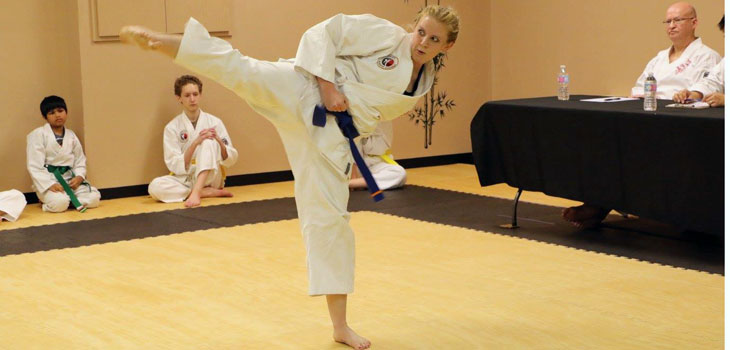
Karate builds confidence that translates into her research, said Kari Roberts.
Whether in the ring, on the slopes or in the pool, bettering your opponent is a big ego boost. So is the satisfaction that comes with getting better and better at your sport with every practice.
When Kari Roberts started work four years ago as evaluation coordinator and postdoc liaison at the MagLab’s Center for Integrating Research and Learning (CIRL), she also started to practice karate. Having steadily advanced from white belt to blue belt to brown, Roberts is slated this month to undergo her black belt test. Perhaps not so coincidentally, the more time she puts in to both pursuits, the more self-assured she becomes.
“Any time you present your research, I think you have to put yourself out there and be prepared for whatever comes back at you: the good, the bad, and the ugly,” Roberts said. “And it is the same thing with karate. It has helped me stay calmer in those situations and to just kind of roll with whatever comes.”
5. Make friends with failure
Not every athlete heads home with the coveted belt, metal or cup, and knowing how to learn from setbacks is a critical skill for any scientist.
As an undergraduate, MagLab geochemist Jeremy Owens landed a tennis scholarship to the University of California, Riverside. But his success on the court depended on his ability to dispassionately examine his mistakes, he said. Even then he was a scientist analyzing data, and the data was himself.
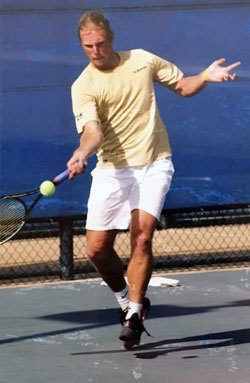
Jeremy Owens.
“You need to be able to critically think about and analyze yourself, look at yourself and say, ‘Well, these are the flaws,’” Owens said. “As a scientist, there are always aspects of your work that may not be perfect, and so you’re trying to figure out how to make that better.”
CIRL Director Roxanne Hughes faced numerous hurdles as a college runner, including a series of injuries.
“Each time I experienced a stress fracture, I learned to reflect on why it was happening and what I could do to prevent it,” said Hughes. “Now as a scientist, I use rejections on grants and articles as information to help me improve my submissions and my scholarship. Rather than giving up, I learned to ask questions and determine how I could improve.”
4. The scientific method
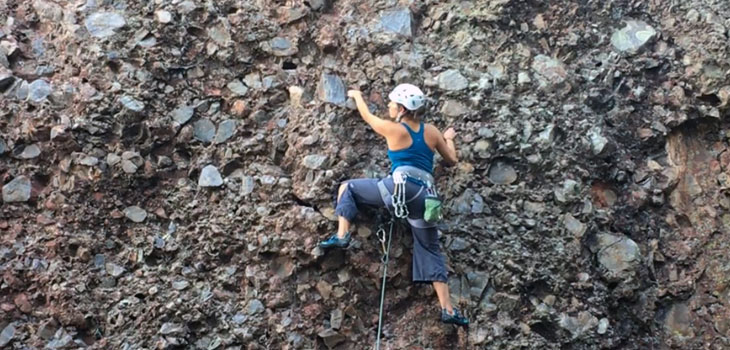
MagLab researcher Roxanne Hughes scales a rock face.
Whatever challenge an athlete may face, the scientific method can help her solve it. Observe, make measurements, experiment with different approaches, evaluate results, repeat.
For Hughes, whose exercise regimen now includes yoga and rock climbing, this underscores that science and sports are, at heart, more about the process than the result. Tackling a rock face, for example, “I ask myself: What are my strengths? How are they helpful on this climb? When I fall, why did I fall?” she said. “By focusing on the process, I get to tinker with different types of training and diet that allow me to continue to explore.”
MagLab scientist Amy McKenna agreed: A little strategic tinkering serves her both in the pool and during experiments, she said.
“As a long distance swimmer and back-stroker, the methodical precision of each stroke is very similar to analytical chemistry,” McKenna said. “Making small improvements — hand position, stroke length — makes transformative improvements in speed.”
3. The long haul
If the devil of science is in those kinds of details, we’ll need a St. Peter for our story, too, to see the big, heavens-eye-view, long-term picture. Because, while success in science and sports relies on lots of properly placed nuts and bolts, it also requires top-notch executive skills.

Chris Reis.
As a world-class swimmer competing for his native Trinidad, Chris Reis learned to plan methodically, and many months in advance, for contests that lasted less than a minute.
“When you get to a level of competiveness at the regional and international levels, there’s a lot that goes into it,” said Reis, a lab assistant at the MagLab’s Applied Superconductivity Center (ASC). “You basically train for nine months and your race is about 30 seconds, and everything has to be perfect.”
To Reis, the parallels to his science are obvious. To Mom, not so much.
“My mom thinks that I mix chemicals and handle metals, but in actuality I am trying to identify plausible bronze electropolishing routes that facilitate niobium-3 tin superconducting radio frequency cavity technology,” said Reis, an undergraduate at the FAMU-FSU College of Engineering. “The level of precision and attention that I paid to swimming has found itself reincarnated in my work here at the ASC.”
2. The 99 percent

MagLab physicist William Coniglio feels the burn as he rows to victory at the 2006 Canadian Henley.
Like Einstein said, there’s plenty of perspiration in science. It can be as painful and monotonous as running laps, doing crunches and repeating drills under a hot sun.
William Coniglio, who won the Canadian Henley regatta twice in the Senior Men's 64kg Single category, is no stranger to sports tedium.
“Training for rowing, you spend a lot of time being very bored and deep in oxygen debt and not particularly comfortable for an hour or more at a time,” Coniglio said.
Turned out to be pretty good training to become a physicist at the MagLab.
“If I can sit on an ergometer for an hour and a half, then I can sit and solder 500 resistors to a circuit board. It’s certainly no more boring than that,” Coniglio said. “Sometimes the process to get to science isn’t particularly enjoyable. It’s not all discoveries and eurekas.”
1. Science is a team sport
While we’re busting science myths, let’s lay to rest the stereotype of the lab coat-clad scientist laboring over his beakers — alone. In the real world, science takes a team.
In New Zealand, this idea is integral to a scientist’s training, according to Kiwi and physicist Neil Sullivan, director of the MagLab’s High B/T Facility.
“In New Zealand, where physics and sports are both highly prized, it was expected that you would join in some athletic activity regardless of talent and learn how important working together as a team could be,” Sullivan said. "That lesson is important in scientific collaboration.”
Former college athlete Daniel Hallinan Jr. knows all about teamwork, and it’s as critical during his experiments as it was on the lacrosse fields at Lafayette College. Hallinan cited a recent experiment about the transport of ions in lithium batteries. The collaborators may not have been wearing matching jerseys, but they communicated effectively, Hallinan said, and each covered his or her position well.
“On the team we had graduate students who were expert in preparing the samples, a visiting scholar who was expert in conducting the MRI experiments and myself, who has expertise in transport phenomena,” Hallinan said. “We each did our part to complete a study that contributed new understanding to the field of polymer electrolytes for lithium batteries.”
So, there you have it: Ten ways athletics helps make good scientists. And that’s something everyone can cheer about.



